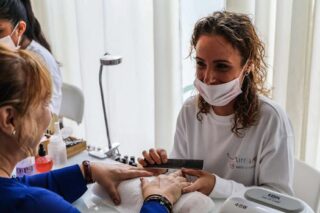
More Pain Management & Rehabilitation Articles
The Hidden Impact of the Sacral Fat Pad on Your Health

The sacral fat pad, a term that may not be widely recognized, plays a subtle yet significant role in our body’s health and comfort. Located at the lower back, just above the buttocks, the sacral fat pad acts as a cushion to protect the sacral bone during prolonged sitting or movement. Understanding its impact can provide insights into various health conditions and overall bodily function.
The Role of the Sacral Fat Pad
The primary function of the sacral fat pad is to provide padding and protection for the sacral region, which is the lower part of the spine. This area can be prone to pressure sores, particularly in individuals who are bedridden or sit for extended periods. The presence of this fat pad helps minimize pressure and reduce the risk of skin breakdown.
Beyond its protective role, the sacral fat pad may also influence posture and comfort. Proper distribution of this fat can support correct spinal alignment, easing tension in the lower back and aiding in comfortable sitting.
Implications for Health and Posture
A healthy sacral fat pad contributes to overall postural stability and comfort. For individuals who spend much of their day seated, such as those in office jobs, maintaining a healthy distribution of sacral fat can prevent discomfort and musculoskeletal issues. Conversely, a diminished sacral fat pad might lead to increased risks of pressure sores or back pain.
Postural health is deeply interconnected with the condition of the sacral fat pad. Ensuring this area is cared for can play a part in broader musculoskeletal well-being. For tips on maintaining a healthy weight and reducing unnecessary fat accumulation, check out our detailed guide on safe and effective weight loss approaches.
Nutritional and Physical Considerations
Nutrition plays a crucial role in maintaining healthy body composition, including the sacral fat pad. A balanced diet rich in essential nutrients supports overall fat distribution and can aid in maintaining postural health. Key nutrients essential in this regard include healthy fats, proteins, and vitamins D and K, which support bone health.
Regular physical activity can also positively affect the sacral fat pad and overall health. Exercises targeting the core and lower back can enhance the strength and flexibility needed to support the sacral region. Activities such as yoga, Pilates, and specific strengthening exercises can be particularly beneficial.
Understanding Changes in the Sacral Fat Pad
Changes in the sacral fat pad can be benign or indicative of underlying health conditions. Weight loss, aging, and certain medical conditions can lead to a reduction in the sacral fat pad, affecting comfort and increasing vulnerability to pressure sores. In contrast, excessive accumulation can result from weight gain, potentially impacting mobility or comfort.
Clinical Observations and Considerations
Healthcare providers might assess the sacral fat pad when dealing with patients at risk of developing pressure sores. Observing the condition of this area can guide interventions and preventive measures. Patients experiencing discomfort in their lower back or bottom should consult with healthcare practitioners for appropriate evaluation and guidance.
While direct clinical intervention is sometimes required, lifestyle and ergonomic adjustments often suffice to manage discomfort related to changes in the sacral fat pad. When appropriate, occupational or physical therapy can be enlisted to further address posture and comfort issues.
For more detailed scientific information on body fat distribution and its health impacts, you may refer to this comprehensive article on Wikipedia’s health page.
Conclusion: The Subtle Impact of the Sacral Fat Pad
The sacral fat pad, while not often discussed, quietly supports the body’s health by protecting vital structures and aiding in posture. By understanding its functions and maintaining a healthy lifestyle, you can contribute to the overall integrity of your lower back health. Remember, balance in diet and physical activity plays a crucial role in sustaining your sacral fat pad and, by extension, your comfort and mobility.
- The sacral fat pad helps protect the sacral bone from pressure-related injuries.
- Proper nutrition and exercise support healthy fat distribution.
- Consult healthcare professionals for concerns about sacral discomfort.
- Maintaining good posture aids in preserving the sacral fat pad.
- Regular assessments can prevent pressure sores in at-risk individuals.
What is the sacral fat pad?
The sacral fat pad is a layer of adipose tissue located at the lower back, providing cushioning for the sacral bone.
Why is the sacral fat pad important?
It protects the sacral region from stress and pressure sores and aids in maintaining proper posture.
How can I maintain a healthy sacral fat pad?
Balanced nutrition and regular exercises that promote core and back strength are key to maintaining a healthy sacral fat pad.
Can weight changes affect the sacral fat pad?
Yes, weight gain or loss can impact the size and efficacy of the sacral fat pad, affecting comfort and postural stability.
Should I consult a doctor about my sacral fat pad?
If you’re experiencing discomfort or suspect changes in your sacral region, it’s advisable to consult a healthcare provider for tailored advice.
Other Articles You May Find of Interest...
- Do Flat Feet Affect Your Knees And Back?
- Long-Term Health Effects of Personal Injuries
- Effective Ways to Alleviate Soreness in Inner Thighs
- The Hidden Impact of the Sacral Fat Pad on Your Health
- Causes of Arm Pain When Sneezing and What You Should Know
- Can I Take Ibuprofen With Amoxicillin?
- Common Questions About Pain and Suffering Answered














